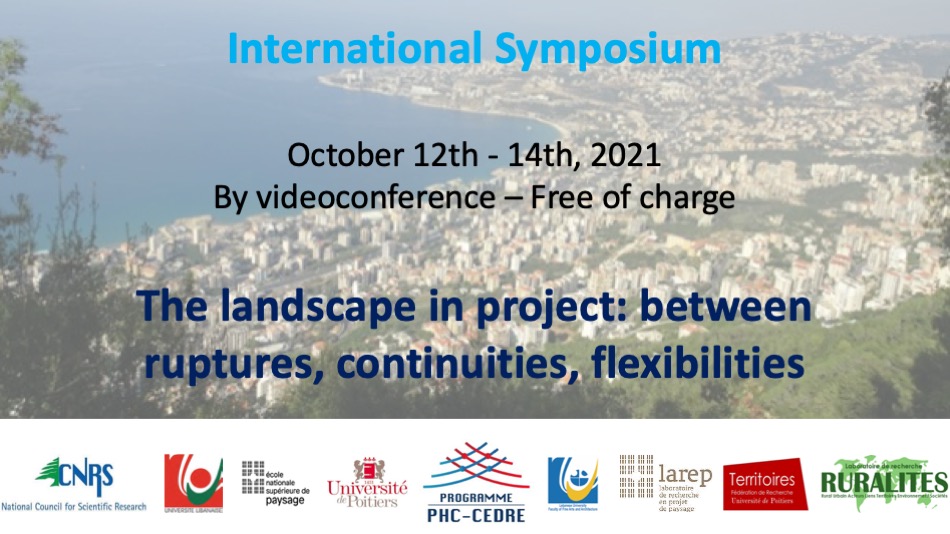
Call for proposalsThe Landscape, in its broadest sense, does not necessarily represent a coherent sequence. In fact, it has the particularity of exhibiting often both ruptures and continuities. These cuts and connections are just as polymorphic as the landscape itself. As “object”, they depend on biophysical materiality and on ecosystems that vary according to environmental conditions. As a product, they also relate to the “subject” in its social, cultural or political variations. The landscape cannot be freed from the territorial context in which it is inscribed, in its spatiality and historical thickness. This socially constructed landscape evolves as a function either of social practices - very strongly marked by globalization - or of implemented projects that renew ways of thinking and managing the territories. The discontinuities in the landscape can be expressed by an imbalance between spatial, geographic, historical, ecological, economic and, sometimes, behavioral levels. According to "Le Robert" dictionary, rupture is defined as a "cut, tearing of a flexible thing" or an "interruption which suddenly affects the permanence of a phenomenon". In this context, it can be an intrusion into the existing, destroying its harmony. By combining the approaches of planners, architects, landscape designers and geographers, etc., this conference aims at questioning the landscape through the prism of its ruptures and continuities. Subject to phenomena of discontinuity (environmental, ecological, economic, etc.), landscapes could adapt to them, showing resilience and flexibility. What forms this emerging flexibility takes in such situations? Four topics will be particularly privileged: The landscape and the project A landscape project is born from the meeting of a designer and actors who interact in the production of a collective work. The landscape project is often conceived from the combination of different converging and diverging factors, including respective intentions, needs and expectations. It tries to articulate the local actor who seeks to confirm his hold on what he considers his domain with the designer who is often influenced by trends and the wishes of users demanding a better living environment. In this area, the reflection will focus on the relationship between the idea and the project, as well as that of the project and the site. What ruptures and continuities between the political intention and the project, between the landscape or territorial project and what is finally implemented? What bifurcations, what adaptations and what forcing? The landscape and the transformation of space By transforming space, the rupture can be geographic and cause marked breaks and landscape discontinuities, the traces of which are still visible in space. One thinks here of the scars of the war, of development interventions which drastically modify the landscapes (quarries, intensive cultivation, plantations and clear cuts in the forest), of actions undermining an established order. What ruptures and what continuities between the built and non-built spaces of the landscape? What landscape patterns and fragmentation could be seen in a context of global change provoking spatial recomposition of territories and subsequent socio-ecological challenges? What public landscape policies in the face of these ruptures and continuities? Many perspectives are emerging within 21st century spatial planning. The urbanization of cities, the search for new resources, the reclamation of privatized public spaces as well as ethnic and confessional conflicts are leading to new phenomena of rupture in the social and spatial landscape. Landscape tools Various landscape approaches are possible when engaging in landscape projects. Depending on the expectations of actors, different tools can be mobilized to better understand the landscape; to raise awareness and engage local stakeholders; to dive in action and planning. Tools allow communicating around and testing different project possibilities. Reflecting spatial representations, landscape tools allow reading ruptures and continuities, changes and invariants. A wide variety of tools (rational or sensitive mapping, atlas, drawing, ground or aerial photography, satellite image, work of art, etc.) participate in the construction of a complex landscape thought and in the development of a knowledge that is enriched by action. This section hence aims at questioning the contribution and / or the relevance of these tools in order to analyze the ruptures and the continuities of the landscape. Landscape users In this section, we are looking into landscape actors / consumers and their relations to the territory. In fact, continuities and ruptures affect the interactions between the landscape and the users. We are here thinking of socio-spatial continuities / ruptures in the landscape as, for example, the materialization of multiconfessionalism in the landscape or as the expression of issues of spatial and social justice. The users of (or in the) landscape are at the same time city dwellers, tourists, and sensitive actors of the landscape. They invent a landscape that becomes sensitive and a vector of emotion. This sensitivity can be understood and shared, misunderstood and rejected. By claiming rights and uses, users create territorialized landscapes and develop practices that shed light on the forms of appropriation of changing spaces.
https://paysage-cedre.sciencesconf.org
|
| Online user: 2 | Privacy |

|
